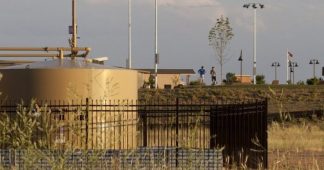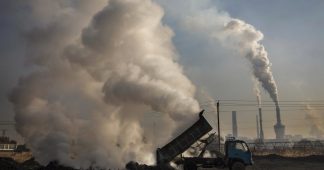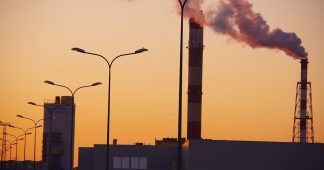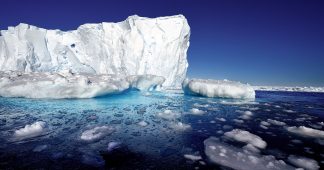NOAA warned that carbon dioxide and methane “continued their unrelenting rise in 2020.”
by
U.S. government scientists warned Wednesday that despite temporary drops in planet-heating emissions due to shutdowns triggered by the ongoing coronavirus pandemic, “levels of the two most important anthropogenic greenhouse gases, carbon dioxide and methane, continued their unrelenting rise in 2020.”
The National Oceanic and Atmospheric Administration (NOAA) also said that the global surface average for carbon dioxide (CO2) last year was 412.5 parts per million (PPM), among the highest rates of increase ever documented since the federal agency started keeping records over six decades ago.
At the Mauna Loa Observatory in Hawaii, the annual mean was 414.4 ppm in 2020.
The figures likely would have been higher if the pandemic hadn’t happened, according to Pieter Tans, senior scientist at NOAA’s Global Monitoring Lab (GML), which measures carbon dioxide, methane, and nitrous oxide from observatories in Alaska, American Samoa, Hawaii, and the South Pole.
“The economic recession was estimated to have reduced carbon emissions by about 7% during 2020,” the agency explained. “Without the economic slowdown, the 2020 increase would have been the highest on record.”
According to NOAA, “Carbon dioxide levels are now higher than at anytime in the past 3.6 million years.”
New release from @NOAA shows that current carbon dioxide levels are the highest that the planet has seen in 3.6 million years.https://t.co/h9QkIO8zzp
— Steve Bowen (@SteveBowenWx) April 8, 2021
NOAA’s 2020 findings came after activists and experts responded with alarm to the concentration of atmospheric CO2 surging past 420 PPM for the first time in recorded history over the weekend. Youth climate leader Greta Thunberg of the Fridays for Future movement said that if that data from Hawaii is confirmed, “it is truly groundbreaking to say the least.”
Colm Sweeney, assistant deputy director of the GML, echoed campaigners’ calls for climate action that followed the latest reading.
“Human activity is driving climate change,” Sweeney said. “If we want to mitigate the worst impacts, it’s going to take a deliberate focus on reducing fossil fuels emissions to near zero—and even then we’ll need to look for ways to further remove greenhouse gasses from the atmosphere.”
However, it’s not just energy policies that need an overhaul. NOAA found that last year saw “a significant jump in the atmospheric burden of methane, which is far less abundant but 28 times more potent than CO2 at trapping heat over a 100-year time frame.”
The agency noted that preliminary analysis “indicates that it is likely that a primary driver of the increased methane burden comes from biological sources of methane such as wetlands or livestock rather than thermogenic sources like oil and gas production and use.”
Still, GML research chemist Ed Dlugokencky said that “although increased fossil emissions may not be fully responsible for the recent growth in methane levels, reducing fossil methane emissions are an important step toward mitigating climate change.”
Inger Andersen, executive director of the United Nations Environment Program (UNEP), tweeted that the”worrying new data” from NOAA demonstrate that climate action “cannot be put on the back burner any longer.”
Worrying new data from @NOAAResearch confirms that despite #COVID19-induced lockdowns, carbon dioxide and methane levels surged in 2020. #ClimateAction cannot be put on the back burner any longer. https://t.co/ukd5BIKAeD pic.twitter.com/36lxTTi1g0
— Inger Andersen (@andersen_inger) April 8, 2021
Reporting Thursday on NOAA’s new research, CBS News pointed out:
Scripps Institution of Oceanography at UC San Diego released similar findings Wednesday, saying their measurements showed atmospheric CO2 levels to be 417.4 PPM at their monitoring station in Hawaii. Scripps noted that this puts atmospheric CO2 levels 50% higher than they were just prior to the industrial revolution.
Scripps also noted that the amount of CO2 accumulating in the atmosphere is accelerating. “It took over 200 years for levels to increase by 25%, but now just over 30 years later, levels are at a 50% increase,” the institution said. Should the current trends continue, it predicts that CO2 levels will be twice as high as pre-industrial levels in about 55 years.
Late last year, the UNEP released a report showing that while the world is headed for a temperature rise over 3°C this century—well beyond the 2015 Paris agreement’s 2°C and 1.5°C targets—a green recovery from the pandemic could cut projected emissions for the next decade by about 25%.
Despite that report and others displaying the necessity of ambitious climate action, U.N. Climate Change concluded in February that national emissions reduction plans—which parties to the agreement are updating ahead of a November summit—are nowhere near where they need to be to meet the Paris goals.
Published at www.commondreams.org











